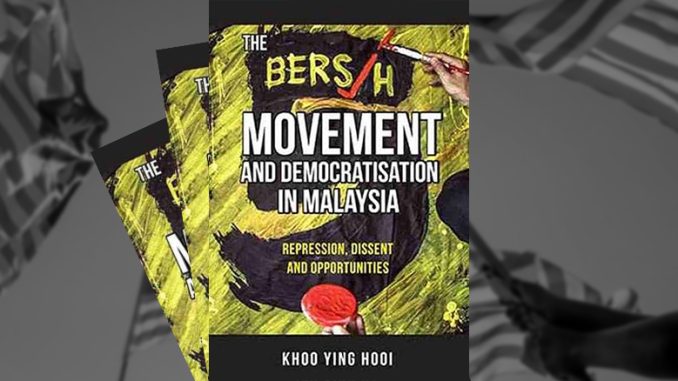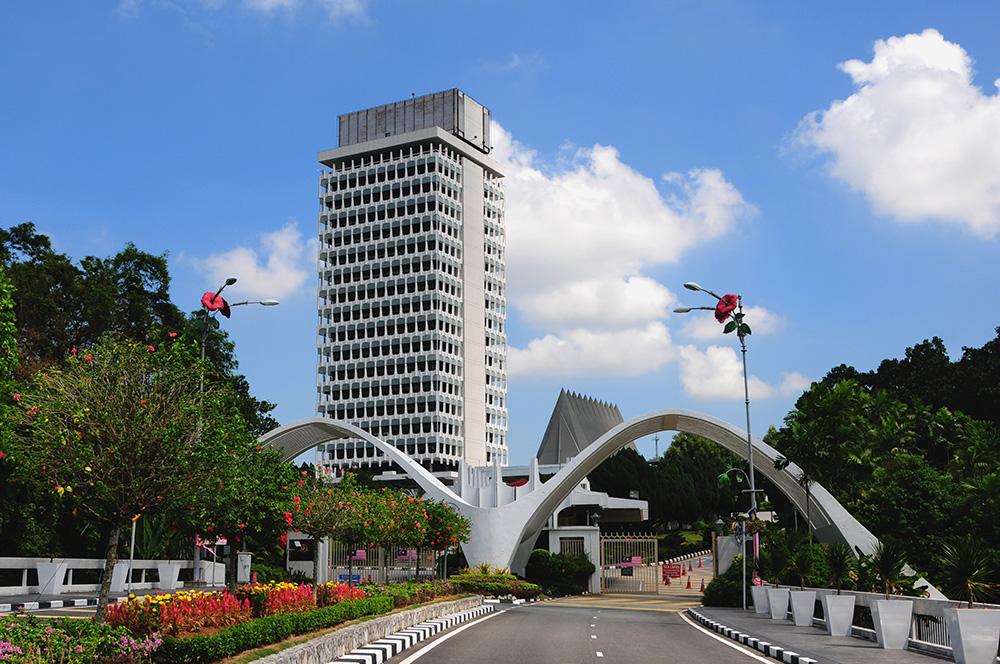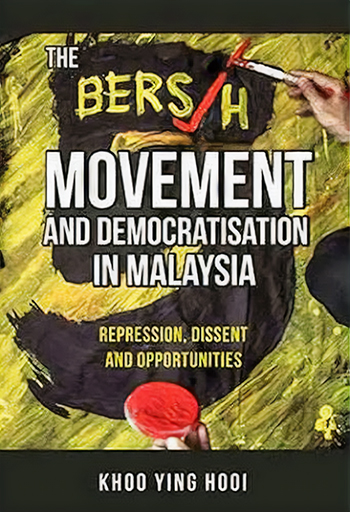
Title: The Bersih Movement and Democratisation in Malaysia: Repression, Dissent and Opportunities
Author: Khoo Ying Hooi
Singapore, ISEAS – Yusof Ishak Institute, 2020
Malaysia has experienced an unstable political situation in recent years, triggered by the defeat of the ruling government Barisan Nasional (BN), which had been in power since independence, in the 2018 general election. The author argues in this book, The Bersih Movement and Democratisation in Malaysia: Repression, Dissent and Opportunities, that changes in political opportunities were brought about by the electoral reform movement, the Coalition for Clean and Fair Elections (Bersih), which contributed to the collapse of the BN regime, namely democratization in Malaysia. The Bersih movement was organized by opposition politicians and later flourished as a nonpartisan civic movement in the late 2000s. It held five street demonstration rallies through 2016 and mobilized 500,000 citizens wearing yellow T-shirts to the capital, Kuala Lumpur, in 2015 (Khoo 2020, p. 81).
This book provides a comprehensive picture of the Bersih movement based on interviews with many individuals involved. While there have been many columns and articles by journalists and researchers analyzing each rally and its relationship with each election or the circumstances, this book discusses why and how the Bersih movement emerged, developed, and led democratization, focusing on the political opportunity structure in Malaysia. Thus, it contributes significantly to both academia and society, both inside and outside Malaysia.

The contents are as follows. After reviewing theories on social movements and democratization (Chapter 2) and providing an overview of the political situation in Malaysia (Chapter 3), the author points out three key factors to explain why and how the Bersih movement arose (Chapter 4): the irregularities of the electoral process, Abdullah Badawi’s administration and public grievances, and the role of the Internet. In Malaysia, the irregularities in the electoral process from the 1960s became evident around the 2000s, causing great grievances among the opposition parties. At that time, Abdullah Badawi, who took over from Mahathir, was expected to carry out political reforms more thoroughly than before, partly because of his clean image. However, as the actual reforms slowed down, the public and civil society became disappointed with his government. Further, the development of the Internet and the growth in its use created a new forum for the public and opposition parties to criticize and debate government policies, fostering political awareness in Malaysia, where media freedom was restricted. In other words, although specific grievances against the government already existed, the opportunity arose to consolidate them, and the resources were in place to promote further action. These factors were critical to the emergence of the Bersih movement
Next, regarding the development of the Bersih movement (Chapter 5), the author explains that there were changes in the political opportunity structure along four dimensions: state repression, access to the political system, availability of allies, and political divisions among elites. While it is difficult to say that state repression entirely weakened, there was an opening up of the political opportunity structure, with fewer arrests at Bersih rallies and an easing in the repression of dissenting voices with the transition to the Abdullah administration. In addition, alliances between social movements, opposition parties, and other NGOs developed, while the ruling parties became more divided, threatening their stability. The author argues that these changes in the political opportunity structure encouraged the Bersih movement to pressurize the government for electoral and political reforms.
Finally, the question arises whether the Bersih movement contributed to democratization in Malaysia (Chapter 6). This is probably the main theme of this book, as the title suggests. For readers familiar with Malaysian and Southeast Asian politics, it will seem obvious that the Bersih movement was at the forefront of recent democratic and liberalization trends in Malaysia. However, those unfamiliar may be skeptical, because the BN regime in Malaysia collapsed through electoral defeat, unlike in countries such as Egypt, where the regime collapsed directly through popular movements like the Arab Spring. Did the movement really have anything to do with and contribute to the regime change?

This doubt is consistent with what has been discussed in previous studies on social movement theory: it is difficult to clarify the precise outcomes or impacts of social movements. As explained by the author, citing Della Porta (2014), “Democratization struggles are seen as processes whose outcomes are influenced by the interactions of different players, some of which pursue democracy as a goal, some opposing it, with some remaining neutral or indifferent” (Khoo 2020, pp. 25–26). That is, if democratization did occur, it is difficult to identify how much the social movement influenced it because there are so many intervening factors and actors. The author states this repeatedly and points out many factors behind the BN’s defeat in GE14, including the 1MDB scandal (the alleged corruption by then Prime Minister Najib and others). However, the author dares to challenge this important conundrum and attempts to logically and academically explain the probably intuitive perception held by many Malaysians—that the Bersih movement is the force that led to democratization.
The author argues that the Bersih movement activated the political participation and awareness of the people, in turn increasing their support for opposition parties. The Bersih movement held an intermittent series of protest rallies from 2007 for which they mobilized numerous citizens. According to the author’s interviews, after its re-launch as a non-party movement in 2010, it was able to arouse more mass political discontent and mobilize larger numbers of people (p. 144). Such an upsurge indicated that the people’s fear, which once existed in Malaysia, of participation in street demonstrations and public debate had been broken.
Furthermore, the impact of the Bersih movement on popular engagement in politics transcended partisanship among the people. The rise of the Bersih movement encouraged the emergence and development of other mass movements and even counter-movements. The author also suggests that the Bersih movement contributed to increased electoral knowledge and awareness among the masses, which in turn led to higher voter turnout. Particularly in the 2013 elections after the Bersih rallies became large, various electoral reform groups emerged to educate citizens about electoral fraud and encourage overseas voters to return to their homes and vote. As a result, turnout reached a record high of 84.84%. Malaysia’s civil society and its activism, which had been sparked by the 1998 Reformasi movement following the arrest of Anwar Ibrahim, had been in decline since then. According to the author, the Bersih movement revitalized it and created a space for ordinary people to participate in politics.
Nevertheless, it is still questionable whether these analyses really overcome the challenge of previous research¾namely, the problem of explaining the outcomes of social movements. The reason is that, as the author notes, there is a mutual interaction between social movements and democratization (Khoo 2020, p. 26). An additional reason is that the emergence and development of social movements are a part of a country’s democratic change itself if it is under an authoritarian regime. In other words, they do not seem to be independent and different phenomena that can be separated into cause and effect or correlated. However, this issue does not detract from the book’s essential contribution. It is also not a shortcoming of this book alone, but rather a fundamental difficulty in clarifying the outcomes of social movements and their impact on democratization. In this respect, this book provides valuable insights into such a general and difficult question through its in-depth case study of Malaysia.
Yukiko Taniguchi
Researcher, Institute of Developing Economies, Japan External Trade Organization
